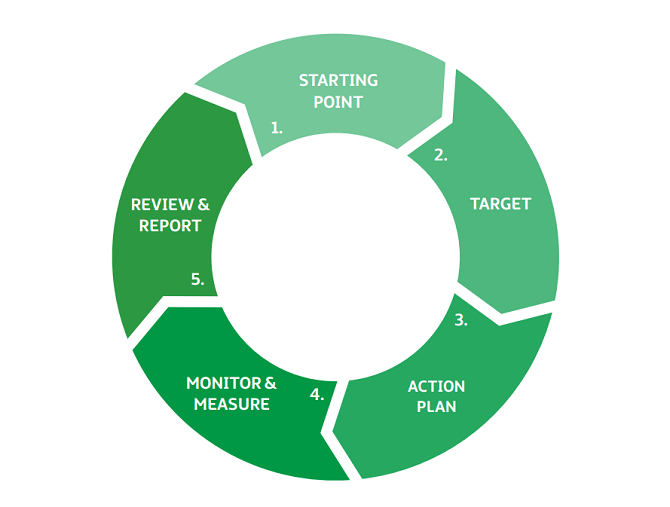Part 2: A Leaner and Greener Roadmap
Contents
A Leaner and Greener Roadmap
A process for managing energy costs and carbon emissions in your business.
The single most important determinant of successful energy management is the commitment and leadership of the business owners and senior managers.
Only senior management can make this topic an strategic business priority. Only senior management can create the conditions for change to happen.
Assuming that managerial support exists, the diagram below shows a good approach to energy management. You will see that it is the same cycle that would apply to the management of any process or system within your business.
- Where are you now? This is your Starting Point.
- Where do you want to get to? This is your Target.
- How will you get there? This is your Action Plan.
- How will you keep track of progress? Use our Leaner & Greener Energy Spreadsheets to help you measure and monitor.
- How will you keep everyone informed? Schedule times for review and reporting within your business.

2.2 Best practice step-by-step approach to managing energy
|
Step 1 : Appoint a Green Champion or Green Team |
|
Appointing a Green Champion or a Green Team is the very first step in saving energy and costs. In a small business, one person may be responsible for this – a Green Champion. In a larger business, it is wise to bring a team of people together – a Green Team. They must have both the responsibility and authority to drive your cost-saving and carbon-saving ambitions. Team members may also need training, meetings, resources and above all time to lead through the rest of the steps below. |
|
Step 2 : Gather data on Annual Energy Use (kWh) and Energy Cost (£) in your business |
|
Top Tips |
|
Step 3: Establish your benchmark against which you will measure future performance |
|
Top Tips |
|
Step 4: Identify the biggest users of energy in your business and rank them from highest to lowest |
|
Top Tips (Use Leaner & Greener Energy Worksheet 2 – Section 3.2) You will need to know the kilowatt rating of each piece of equipment*, approximately how long it is on for every day and your Average Unit Price (which you calculated in Step 2). The worksheet will help you work out exactly how much money each piece of equipment costs over the course of a year. You may be surprised! You will then be able to prioritise actions around equipment. |
|
Step 5: Observe staff and customer behaviour in managing and using equipment |
|
Top Tips |
|
Step 6: Evaluate the options for replacing your current energy sources with renewable energy alternatives |
|
Top Tips |
|
Step 7: Develop your Energy Action Plan (Use the Leaner & Greener Energy Action Plan Template) |
|
Top Tips |
* How to establish the kilowatt rating of a piece of equipment? You may find it in the manual or you may be able to find it on the product specification online. You can also use a meter to get the exact kilowatt rating of any piece of equipment.
Data is your Friend
There are a number of important reasons why measuring and monitoring data is central to your energy management journey:
- Your ability to report accurately and memorably on your successes in saving energy depends on how well you keep track of your key numbers.
- To apply for independent certification, you must provide data on energy consumption in your business and be able to demonstrate improvements as a result of actions you take.
- Similarly, to apply for and win green awards, you must provide evidence of improvements.
Your data is that evidence. - Sharing data with your staff makes the Energy Saving Project meaningful and transparent. When the data reveals the impact of their actions on the consumption and cost figures, your team will be motivated and inspired to continue with the journey.